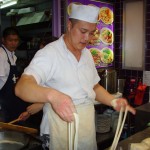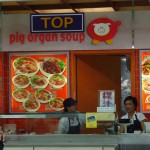Restaurants
- Noodle wrangler at Shanghai Delights, Jurong Point Mall
- Fruit and juice stand at the halal food court
- Not halal
Someone asked me if we’d been to a good restaurant in Singapore, and it took me a while to figure out how to answer. Singapore is riddled with food outlets, at every mall, at every bus depot, every train station (well, almost), every housing development. There are regular restaurants in malls and downtown, but mostly there are food centers, kind of like American food courts only much more fun. Each one is run by a consortium (Food Republic, Kopitiam, Broadway, Banquet) whose logo appears on the plates. It consists of a central seating area with lots of tables and chairs, all moveable, a bussing station for the elderly people who clear the plates, and at least fourteen stalls around the sides selling specialties. Hong Kong Delights, Indo Caterina, Shanghai Noodles, Pig Organ Soup. You claim a table by putting down a packet of tissues, then go to whichever stall sells your fancy, buy it for between $2 and $6, and then bring it back to the table and eat. There’s a roar and hubbub as people come and go, kids giggle and whine, people chat over their coffee, so it’s not restful and relaxing but the food is fast, made on the spot, and good.
If it’s not good, the stall goes out of business. I had a particularly tasteless “Middle Eastern” plate from a stall that never has any customers, and I’m waiting to see it empty out and fill with someone with a sensitive palate. Each stall has its own specialty, whose ingredients are ready to go: tea or coffee is brewed (doubly or triply in some cases), broth bubbling, meat fried, fruit cut, noodle dough made. When you ask for your desired dish, the cook slices and dices, adds condiments, puts the fruit through the juicer, or pulls the noodles before your eyes and pops them into the vat of boiling water. The various ingredients are assembled into the advertised dish within about 2 minutes. You pay, pick up a pair of chopsticks or a fork, serve yourself a small dish of chili sauce or sambal in case it needs enlivening, and off you go.
Even school cafeterias have modified food courts. They have to cater to Hindu vegetarians, Muslim halal needs, and majority Chinese tastes, so every school has at least three mini-kitchens serving up different fresh foods. My daughter will never be able to go back to American school, unless she reverts to a lunch menu of crackers and peanut butter from home.
Nanyang Technological University, where we live, has fourteen food courts and a slew of cafes and restaurants. The food courts are even cheaper than those in the rest of the city, because they cater to students and they pay lower rent. So the three of us can eat dinner for about $7, as we did last night. For a small family, there’s not a lot of incentive to cook.
One of Ram’s colleagues has a son who grew up here but now attends a university in Manchester in the U.K. The hardest thing for him to get used to is not the climate, but the fact that there’s nobody to make him fresh noodles.



October 6th, 2008 at 1:41 pm
Do I sense glee in not having to cook every day? I like your cooking, though.
We had dinner today in Tied House at Mountain View, a local brewery and sports bar. The food was quite good, but I was shocked by the amount of solid fat and protein in every dish — we could even taste the calories! The Asian restaurants, especially small and casual ones, don’t seem to put much more grease than home cooking (with the exception of Sichuan cuisine, perhaps), therefore it is a lot more feasible to skip cooking at home in a place like Singapore.
October 7th, 2008 at 9:15 am
Hm. I know what you mean. Singapore food has a lot of fried elements, but overall you’re not stuck eating solid blobs of butterfat (butter, cheese). And the meat is in little bits and pieces, not great greasy chunks. Of course it’s not fair to compare it to bar food – that’s supposed to be oily and salty, to encourage you to buy more beer.
Is American food more fatty? The European base for it certainly could be – when we watch Julia Childs we are agog at how much butter and cream she adds to stuff. Is it the serving sizes? And the gross amounts of extra cheese and greasy meats American food outlets add to pizzas make them way more dangerous than the Neapolitan original, with just mozzarella and maybe some anchovies. OK, time to reread “Fast Food Nation.”
I do have a certain amount of glee in not cooking, but if Ram eats out all the time he grows unhappy. So I tend to make dinner fairly frequently. But since I’m away from my native heath I cook different stuff – partly as an experiment with the sorts of ingredients I find in the shops, partly because I can’t stand spending much time in our stuffy kitchen, and partly because I can’t find the sorts of ingredients and equipment I have at home. To get peanut butter that we like – no sugar or preservatives – without paying for it as if it were medicine, for example, we have to make it.
I find, though, that there’s a surfeit of possibilities. Sometimes we go to these food centers and I just can’t be bothered to decide among the fifteen types of noodles and twenty-six soup bases, the foods of seven different cultures. I just want a damn sandwich!
October 7th, 2008 at 10:57 am
Speaking of eating out, I had my comprehensive health checkup today. I was dreading it because the questionnaire asked how many days a week I eat out. My answer was 7. I have to wait for the test results, but at least one number is positive. I’ve lost some weight since coming here, according to the scale at the clinic. On the way back to my office, I found out that the staff welfare committee (yes, there is one) had set out lots of yummy fried food and good thick coffee in the common room
October 7th, 2008 at 4:04 pm
Gee, would this be the same welfare committee that hands out fruit on “Healthy Eating Day,” and is responsible for the “Eat Healthily” fridge magnet at our apartment?
You’re probably losing weight because I’m cooking so badly. Sorry! Well, maybe not….